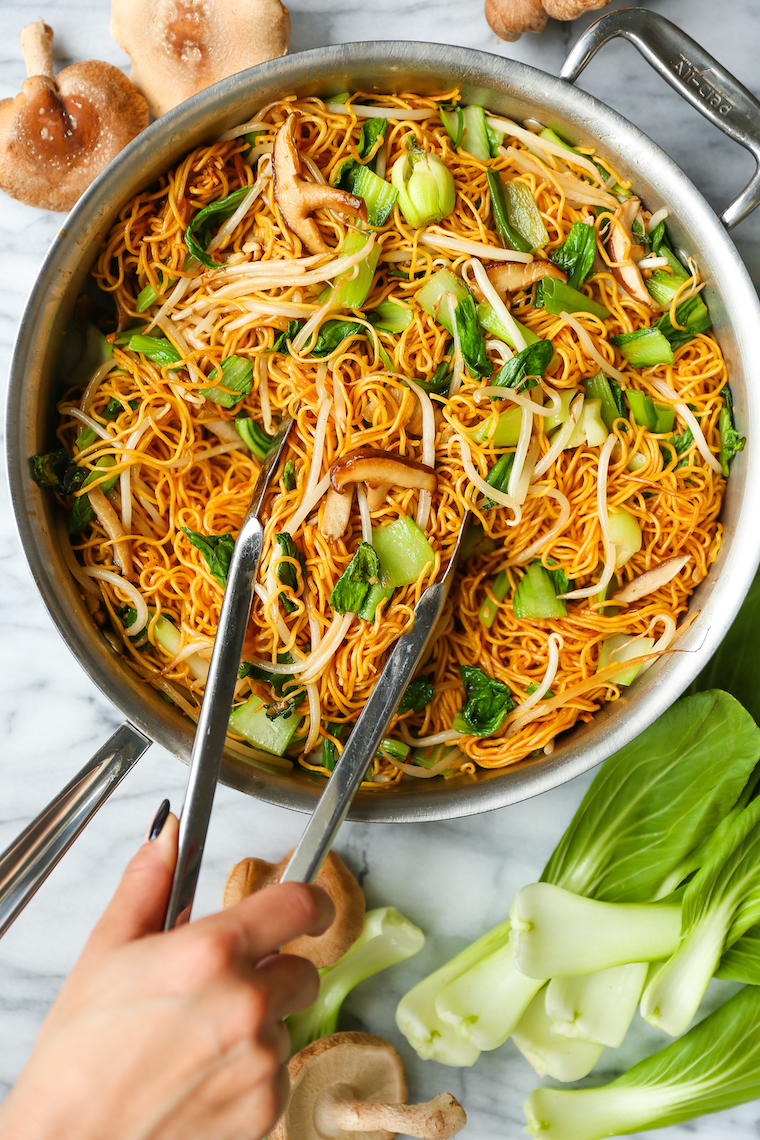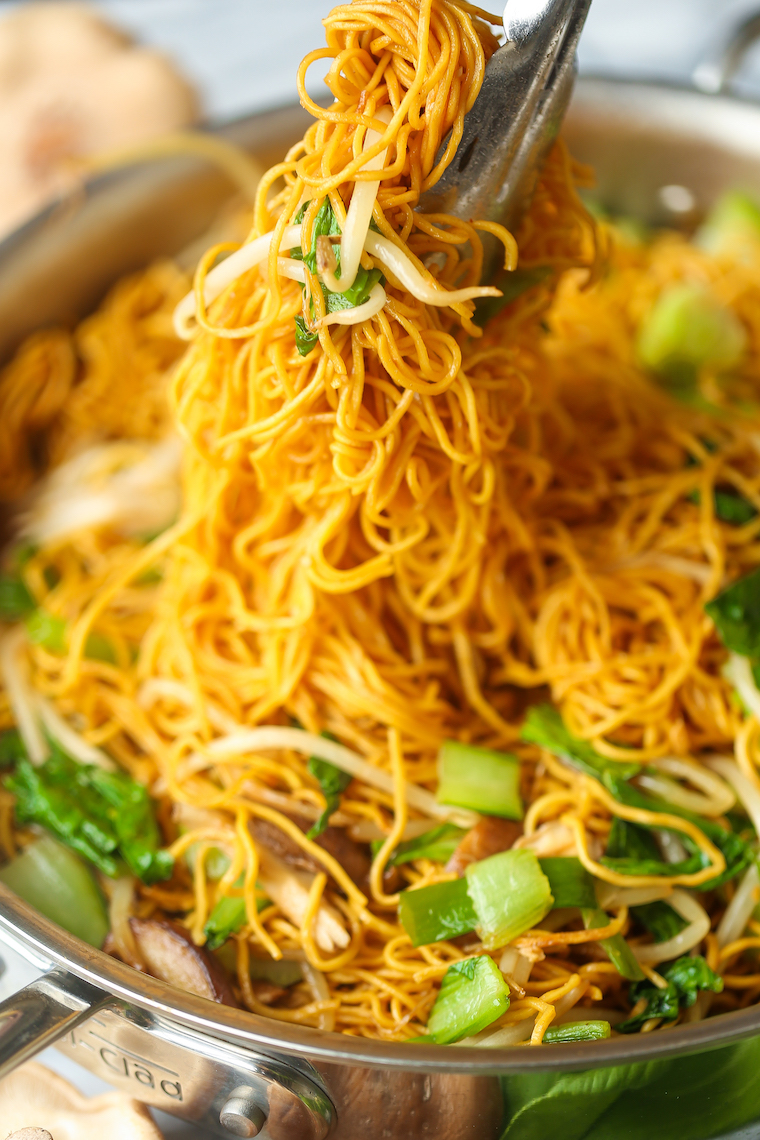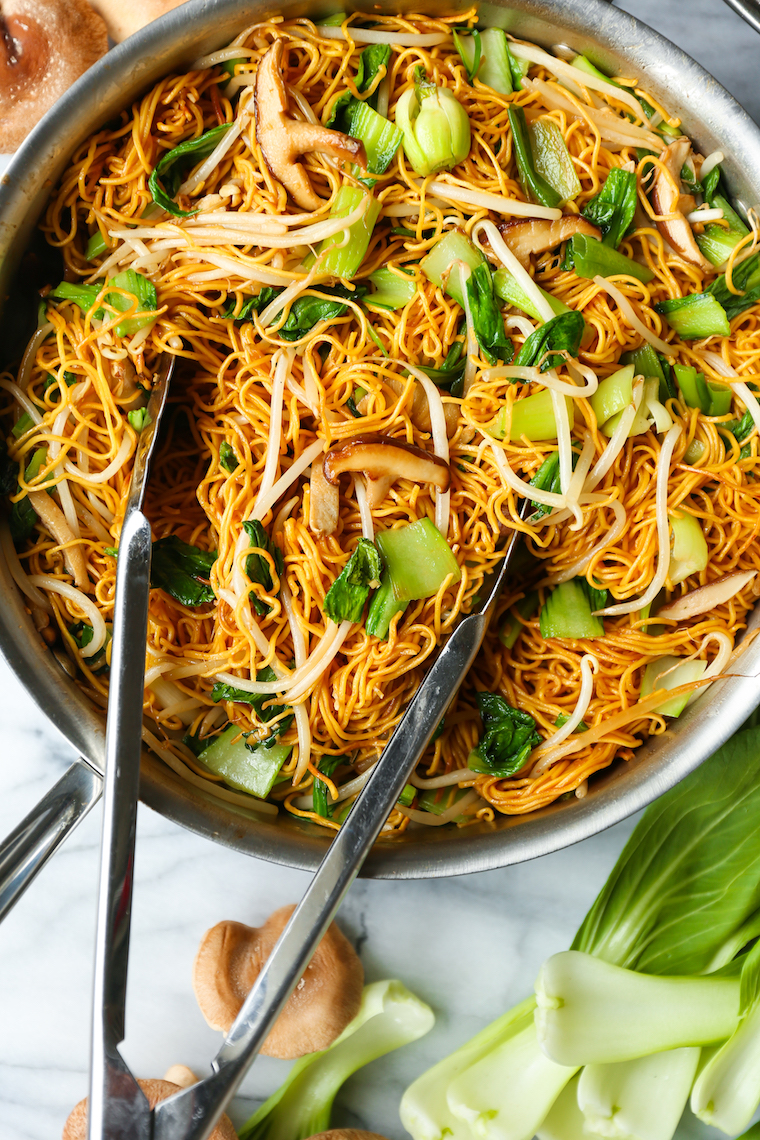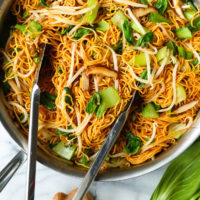Easy Chow Mein
Skip the takeout and make the BEST chow mein at home in less than 30 min! Perfectly crispy noodles with bok choy, mushrooms + bean sprouts!

We were ordering Chinese take-out from one of my favorite places. And all I really wanted was a giant bowl of chow mein with pan-fried noodles to that perfect crispness and crunch.
Except Ben says to me, “I think it’s lo mein that you want.” I was hesitant. I was 99% certain it was chow mein that I was looking for. He said, “Doesn’t the ‘chow’ in chow mein mean rice?”
I should have just stopped listening to him right there. Instead, I ordered the lo mein and I did not get my crispy noodles. And someone slept on the couch that night.

So in case you all are wondering, that is the key difference to chow mein versus lo mein. Chow mein noodles are fried to crispness while lo mein noodles are boiled to softness.
Both are great – but sometimes you just want those crispy noodles.
So after that mix up, I’ve been trying to perfect a homemade chow mein dish. You know, so I don’t have to constantly fight about chow mein versus lo mein with Ben.

And lo and behold, I think I’ve got it. This recipe here is created with the most perfect crispy noodles made with Hong Kong-style pan-fried noodles.
This can be found at your local Asian grocery store, and is usually sold parboiled so they can be used straight from the bag to pan without boiling them first, yielding that amazingly crisp firmness with soft, chewy spots throughout.
But if you can’t find them or they are not available, don’t worry. Fettuccine, linguine, or even ramen noodles (with the seasoning packet discarded) make for a handy substitute!

Easy Chow Mein
Ingredients
- ¼ cup oyster sauce
- 1 tablespoon soy sauce
- 3 cloves garlic, minced
- 2 teaspoons freshly grated ginger
- 1 teaspoon Sriracha
- 1 (16-ounce) package Hong Kong-style pan-fried noodles
- Kosher salt and freshly ground black pepper, to taste
- 2 tablespoons canola oil
- 1 (3.5-ounce) package shiitake mushrooms
- 4 baby bok choy, coarsely chopped
- 1 cup mung bean sprouts, rinsed and drained
Instructions
- In a small bowl, whisk together oyster sauce, soy sauce, garlic, ginger and Sriracha; set aside.
- Heat 1 tablespoon canola oil in a large skillet or wok over medium high heat. Add noodles and cook, stirring constantly, until golden brown and crispy, about 3-4 minutes; set aside.
- Heat remaining 1 tablespoon canola oil in the skillet. Add mushrooms, and cook, stirring often, until tender, about 3-4 minutes. Stir in bok choy until just wilted, about 1 minute.
- Stir in noodles and oyster sauce mixture until well combined, about 2 minutes. Stir in bean sprouts.
- Serve immediately.
Did you make this recipe?
Tag @damn_delicious on Instagram and hashtag it #damndelicious!


Very delicious. I used soft chow mein noodles.
This recipe was amazing!
First time cooking with chow mein and was so happy with the results. I added tofu, it was so flavorful; thank you!!
If you have other vegetarian recipes on your site I will definitely try!!
do rice noodles work as a subsitute for hong kong style noodles ?
I was wondering, if i wanted to just eat noodles with no vegetables could i just use this recipe for noodles and not include any vegetables? Would it still work?
Hey I want to try you recipe. I am a vegetarian. What can I replace oyster sauce with?
If you go to a specialty Asian food store, you might actually find a product called “vegetarian oyster sauce”, which is pretty much the same thing. Failing that, you can always substitute soy sauce or hoisin sauce if you want a less watery texture.
Can you use fish sauce instead of oyster sauce? Or would the taste be very different. I have every other ingredient except the oyster sauce.
Yes, the taste will vary quite a bit.
I have a vegetarian stir fry sauce that my parents bough from the Asian food store could i replace the oyster sauce with that?
What a great idea! But unfortunately, without having tried this myself, I cannot answer with certainty. But if you get a chance to try it, please let me know how it turns out! Good luck! 🙂
Mein = noodles
Chow = fried or sautéed
Lo = pulled up with a strainer
Going to make this recipe, but do I cook the Raman noodles first or use directly into pan?
Hi Carmen! You can add the Hong Kong-style pan-fried noodles directly into the pan. 🙂
Hi! I made this using angel hair pasta instead of chow mein noodles. It turned out to be a bit wetter than expected. Should I fry the angel hair pasta, just like how you fried the chow mein noodles first? Is there a particular reason for frying the noodles first?
Hi Michelle! Did you cook the angel hair pasta in water and then add it to the recipe later? That would explain why it turned out wetter. We recommend using chow mein noodles because you can fry them to get that amazing crispness, rather than cooking in water which would add unwanted moisture. Hope that answers your question! 🙂
I made this tonight. It smelled yummy, but I had trouble cooking the noodles without some burning. Dish had a nice flavor, but quite dry. My only substitution was scallions instead of mung beans. What could I do to make it a little less dry?
You can try to add a bit more sauce to your liking, Judy. 🙂
SO GOOD! This will be a go to recipe that will be used again and again!
I used chicken and whatever vegetables I had in the house. I could not stop eating it!
YUM!
It’s such a versatile recipe! Glad you enjoyed it, Dawn! 🙂
Delicious! Although i used half a teaspoon of sambal oolek in place of sriracha and omg that stuff had our noses running! Way hotter than sriracha
Sambal oelek is so so good but super spicy! Runny noses for the win! 🙂
This look so good! I would love to try this recipe but I have a picky eater at home when it comes to vegetables. 🙁
Is there another vegetable mix I can add instead of bok choy, mushrooms and bean sprouts?
You can add any other vegetable of your choice, Lee (ex. carrots, celery, cabbage, etc.). 🙂
I used Soba noodles instead of regular ones for more flavor and it was A-MA-ZING . Finger licking super easy and versatile recipe . Thank you so much !
You are so welcome, Haffeda!
Hah! Funny story. Mein means noodles while chow means “stir fried”. Lo means “mixed”.
I put in some snow peas and green onions, in addition to the bok choy and mushrooms (didn’t have any bean sprouts). Turned out really well – thanks!!
Great additions, Richard! Thanks for sharing with us!
Do I find the Hongkong Style Noodles in the refrigerator section of my Asian grocery? Is it the crunchy or soft kind before cooking?
You should be able to find it in the refrigerated section.
Question:
would love to make this dish but, I am allergic to oyster sauce, what can I use in its place instead?
If you mix soy sauce and hoisin sauce at a 1:1 ratio, the result will be close enough to oyster sauce to get you by. But as always, please use your best judgment when making substitutions and modifications.
This was wonderful. I actually splint into 2 batches. One I ate as is. Delicious! The other half I added some leftover chicken and shrimp. Did not have enough for whole batch and this was going to be a complete meal so I split the other in half. OMG so good. Love the flavors. Thank you once again.
I bet that was very tasty! Thanks for sharing with us, MsLindaT!
Question: if you are not using the Hong-Kong style noodles and using regular pasta as you commented on instead, do I parboil it first? Thanks.
Yes, the pasta should be cooked according to package instructions.
I appreciate your sharing
thank you
I’m having trouble finding HK style pan fried noodles. Are they the same as yakisoba noodles?
They are not the same but you can certainly use it as a handy substitute.